Think Big: Exploring Drone Technology in Agriculture - Business Report
VerifiedAdded on 2021/05/31
|19
|2718
|52
Report
AI Summary
This report presents a comprehensive evaluation of an innovative business idea that leverages drone technology and disruptive technologies like machine learning to enhance the farming industry. The core concept revolves around utilizing drones to improve crop health, monitor fields, and analyze predictive patterns, offering farmers high-tech solutions for precision agriculture. The report details the customer problem, emphasizing the challenges farmers face in monitoring and managing their land to meet global demands. It outlines the benefits of drone technology, including data collection, real-time field imagery, and the ability to detect pests and predict climate changes. The proposed business model includes key partners, activities, value propositions, customer relationships, and revenue streams. Critical success factors, product, target market, organizational, and financial feasibility are also evaluated. The report concludes that while the product and target market feasibility are strong, financial feasibility may be a challenge due to the high initial costs. Overall, the study highlights the potential of drones to revolutionize farming practices and improve efficiency.
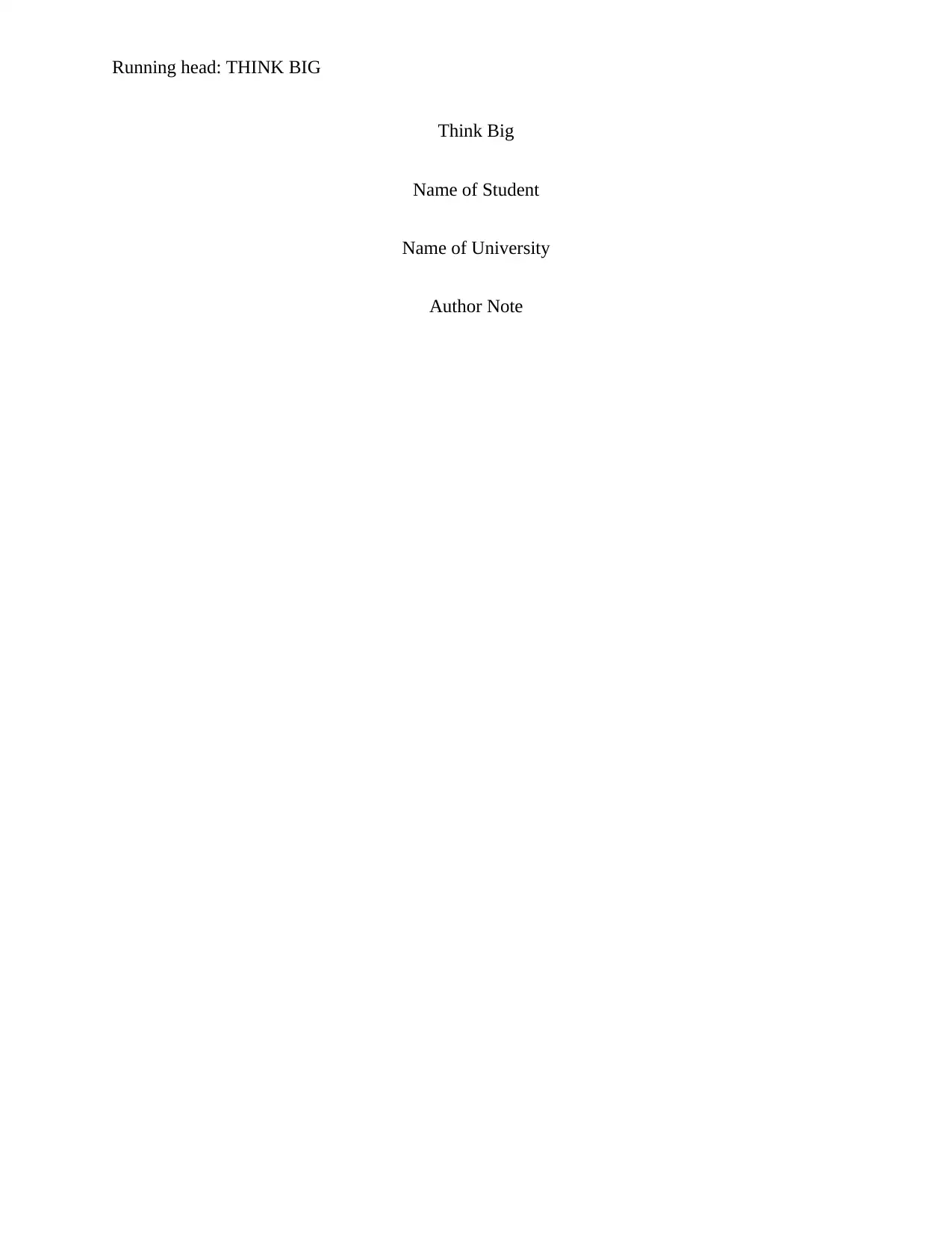
Running head: THINK BIG
Think Big
Name of Student
Name of University
Author Note
Think Big
Name of Student
Name of University
Author Note
Paraphrase This Document
Need a fresh take? Get an instant paraphrase of this document with our AI Paraphraser

1
THINK BIG
Executive Summary
The study is mainly focused on the evaluation and feasibility of innovative business idea to be
presented in a comprehensive manner. The innovative business idea of using drone with some of
the disruptive technologies helps in enhancing the scope of research for the farming industry
around the globe. This will provide a new direction for the farmers to adopt the high tech
farming practices for improving the health and analyze the predictive patterns of the crops. This
new business idea would surely encourage the farmers to deal with new inventions and
applications of drone in the near future.
THINK BIG
Executive Summary
The study is mainly focused on the evaluation and feasibility of innovative business idea to be
presented in a comprehensive manner. The innovative business idea of using drone with some of
the disruptive technologies helps in enhancing the scope of research for the farming industry
around the globe. This will provide a new direction for the farmers to adopt the high tech
farming practices for improving the health and analyze the predictive patterns of the crops. This
new business idea would surely encourage the farmers to deal with new inventions and
applications of drone in the near future.
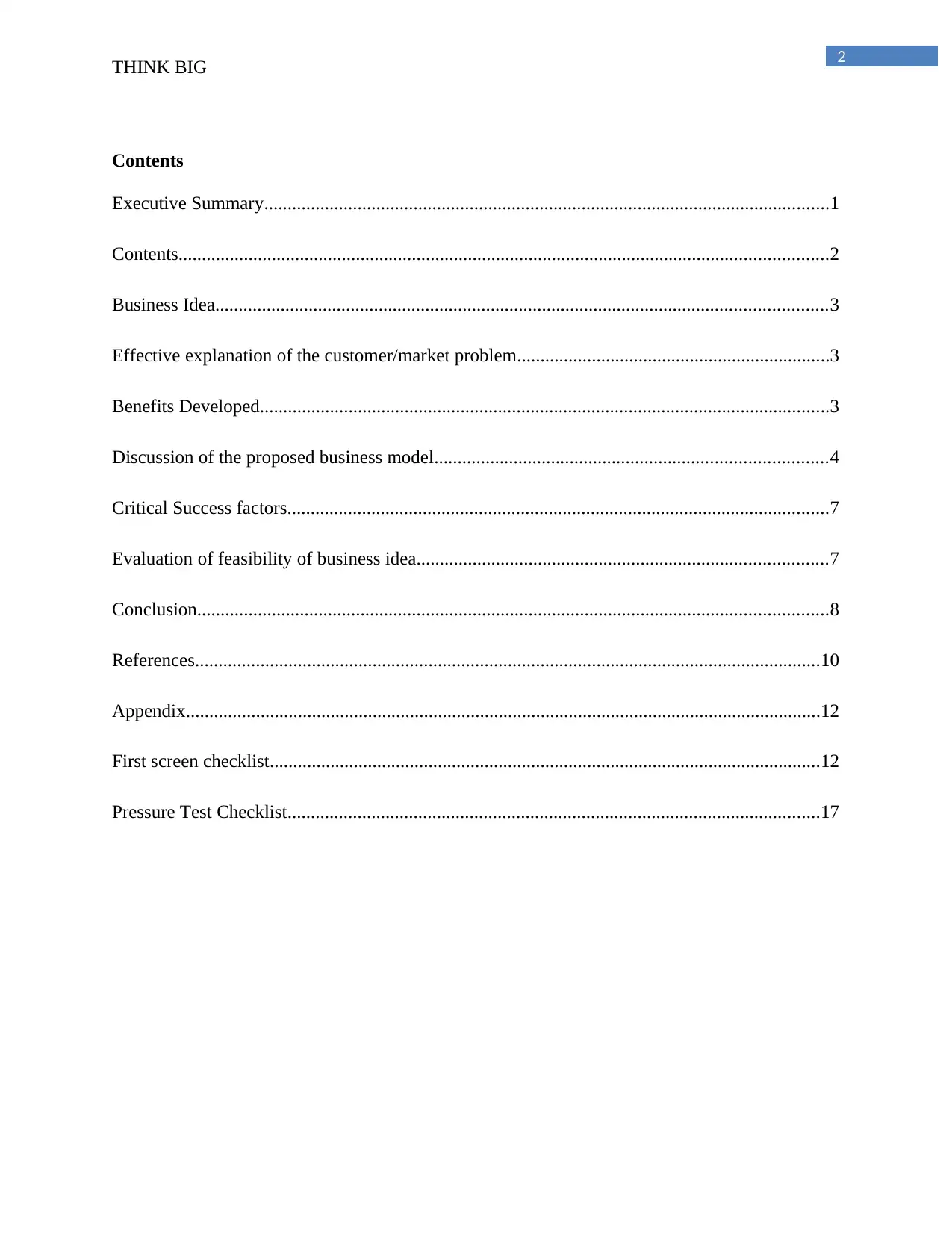
2
THINK BIG
Contents
Executive Summary.........................................................................................................................1
Contents...........................................................................................................................................2
Business Idea...................................................................................................................................3
Effective explanation of the customer/market problem...................................................................3
Benefits Developed..........................................................................................................................3
Discussion of the proposed business model....................................................................................4
Critical Success factors....................................................................................................................7
Evaluation of feasibility of business idea........................................................................................7
Conclusion.......................................................................................................................................8
References......................................................................................................................................10
Appendix........................................................................................................................................12
First screen checklist......................................................................................................................12
Pressure Test Checklist..................................................................................................................17
THINK BIG
Contents
Executive Summary.........................................................................................................................1
Contents...........................................................................................................................................2
Business Idea...................................................................................................................................3
Effective explanation of the customer/market problem...................................................................3
Benefits Developed..........................................................................................................................3
Discussion of the proposed business model....................................................................................4
Critical Success factors....................................................................................................................7
Evaluation of feasibility of business idea........................................................................................7
Conclusion.......................................................................................................................................8
References......................................................................................................................................10
Appendix........................................................................................................................................12
First screen checklist......................................................................................................................12
Pressure Test Checklist..................................................................................................................17
⊘ This is a preview!⊘
Do you want full access?
Subscribe today to unlock all pages.

Trusted by 1+ million students worldwide
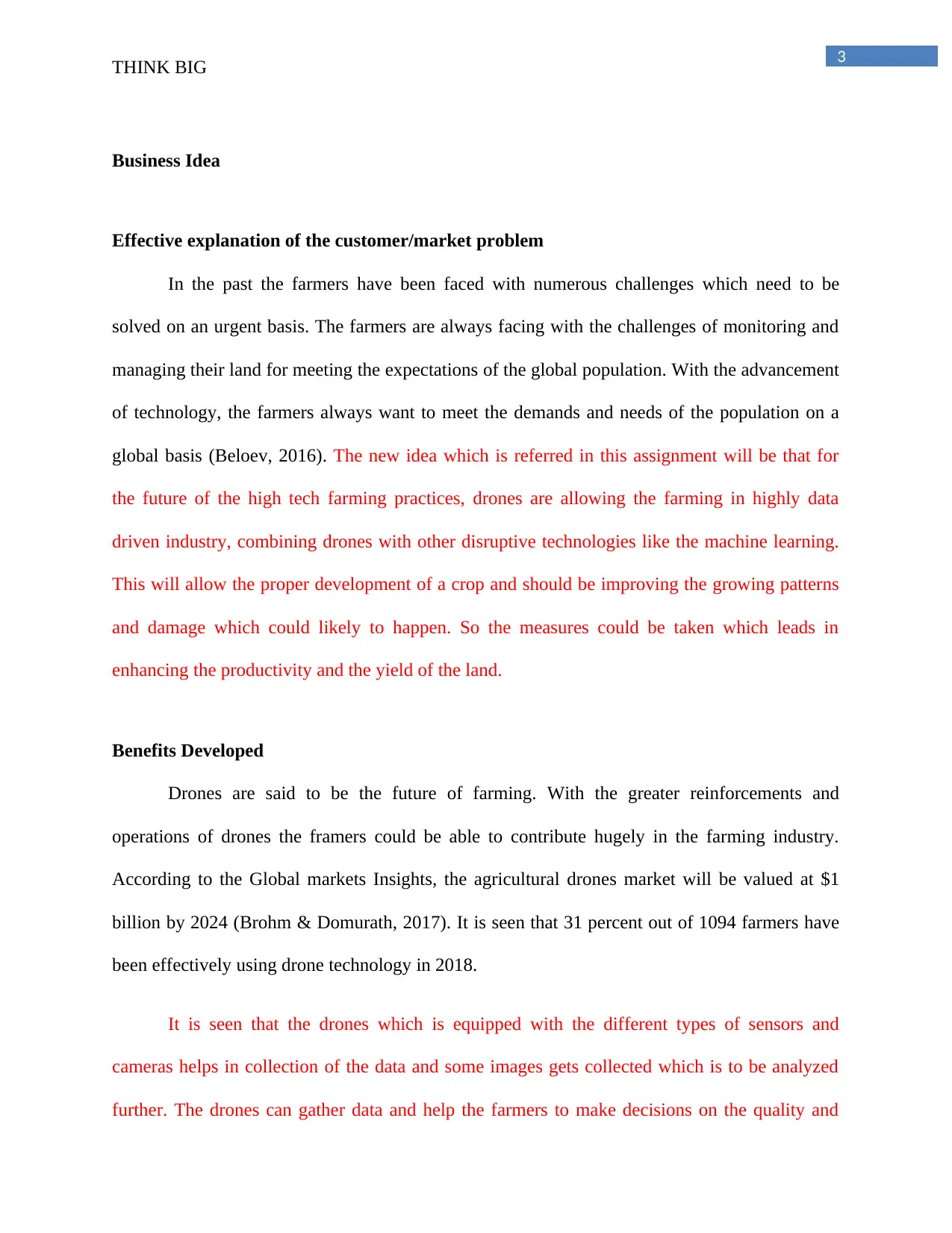
3
THINK BIG
Business Idea
Effective explanation of the customer/market problem
In the past the farmers have been faced with numerous challenges which need to be
solved on an urgent basis. The farmers are always facing with the challenges of monitoring and
managing their land for meeting the expectations of the global population. With the advancement
of technology, the farmers always want to meet the demands and needs of the population on a
global basis (Beloev, 2016). The new idea which is referred in this assignment will be that for
the future of the high tech farming practices, drones are allowing the farming in highly data
driven industry, combining drones with other disruptive technologies like the machine learning.
This will allow the proper development of a crop and should be improving the growing patterns
and damage which could likely to happen. So the measures could be taken which leads in
enhancing the productivity and the yield of the land.
Benefits Developed
Drones are said to be the future of farming. With the greater reinforcements and
operations of drones the framers could be able to contribute hugely in the farming industry.
According to the Global markets Insights, the agricultural drones market will be valued at $1
billion by 2024 (Brohm & Domurath, 2017). It is seen that 31 percent out of 1094 farmers have
been effectively using drone technology in 2018.
It is seen that the drones which is equipped with the different types of sensors and
cameras helps in collection of the data and some images gets collected which is to be analyzed
further. The drones can gather data and help the farmers to make decisions on the quality and
THINK BIG
Business Idea
Effective explanation of the customer/market problem
In the past the farmers have been faced with numerous challenges which need to be
solved on an urgent basis. The farmers are always facing with the challenges of monitoring and
managing their land for meeting the expectations of the global population. With the advancement
of technology, the farmers always want to meet the demands and needs of the population on a
global basis (Beloev, 2016). The new idea which is referred in this assignment will be that for
the future of the high tech farming practices, drones are allowing the farming in highly data
driven industry, combining drones with other disruptive technologies like the machine learning.
This will allow the proper development of a crop and should be improving the growing patterns
and damage which could likely to happen. So the measures could be taken which leads in
enhancing the productivity and the yield of the land.
Benefits Developed
Drones are said to be the future of farming. With the greater reinforcements and
operations of drones the framers could be able to contribute hugely in the farming industry.
According to the Global markets Insights, the agricultural drones market will be valued at $1
billion by 2024 (Brohm & Domurath, 2017). It is seen that 31 percent out of 1094 farmers have
been effectively using drone technology in 2018.
It is seen that the drones which is equipped with the different types of sensors and
cameras helps in collection of the data and some images gets collected which is to be analyzed
further. The drones can gather data and help the farmers to make decisions on the quality and
Paraphrase This Document
Need a fresh take? Get an instant paraphrase of this document with our AI Paraphraser
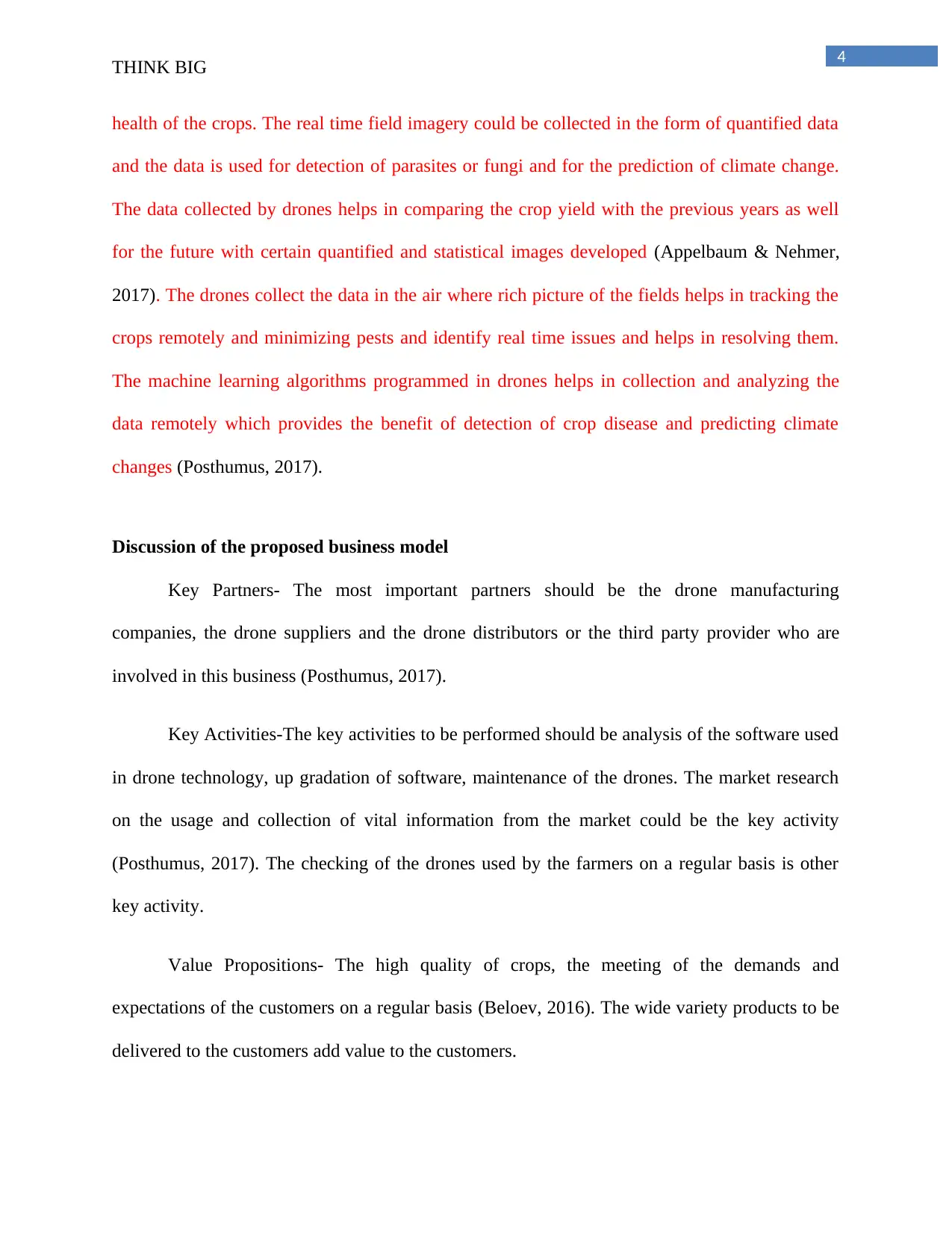
4
THINK BIG
health of the crops. The real time field imagery could be collected in the form of quantified data
and the data is used for detection of parasites or fungi and for the prediction of climate change.
The data collected by drones helps in comparing the crop yield with the previous years as well
for the future with certain quantified and statistical images developed (Appelbaum & Nehmer,
2017). The drones collect the data in the air where rich picture of the fields helps in tracking the
crops remotely and minimizing pests and identify real time issues and helps in resolving them.
The machine learning algorithms programmed in drones helps in collection and analyzing the
data remotely which provides the benefit of detection of crop disease and predicting climate
changes (Posthumus, 2017).
Discussion of the proposed business model
Key Partners- The most important partners should be the drone manufacturing
companies, the drone suppliers and the drone distributors or the third party provider who are
involved in this business (Posthumus, 2017).
Key Activities-The key activities to be performed should be analysis of the software used
in drone technology, up gradation of software, maintenance of the drones. The market research
on the usage and collection of vital information from the market could be the key activity
(Posthumus, 2017). The checking of the drones used by the farmers on a regular basis is other
key activity.
Value Propositions- The high quality of crops, the meeting of the demands and
expectations of the customers on a regular basis (Beloev, 2016). The wide variety products to be
delivered to the customers add value to the customers.
THINK BIG
health of the crops. The real time field imagery could be collected in the form of quantified data
and the data is used for detection of parasites or fungi and for the prediction of climate change.
The data collected by drones helps in comparing the crop yield with the previous years as well
for the future with certain quantified and statistical images developed (Appelbaum & Nehmer,
2017). The drones collect the data in the air where rich picture of the fields helps in tracking the
crops remotely and minimizing pests and identify real time issues and helps in resolving them.
The machine learning algorithms programmed in drones helps in collection and analyzing the
data remotely which provides the benefit of detection of crop disease and predicting climate
changes (Posthumus, 2017).
Discussion of the proposed business model
Key Partners- The most important partners should be the drone manufacturing
companies, the drone suppliers and the drone distributors or the third party provider who are
involved in this business (Posthumus, 2017).
Key Activities-The key activities to be performed should be analysis of the software used
in drone technology, up gradation of software, maintenance of the drones. The market research
on the usage and collection of vital information from the market could be the key activity
(Posthumus, 2017). The checking of the drones used by the farmers on a regular basis is other
key activity.
Value Propositions- The high quality of crops, the meeting of the demands and
expectations of the customers on a regular basis (Beloev, 2016). The wide variety products to be
delivered to the customers add value to the customers.
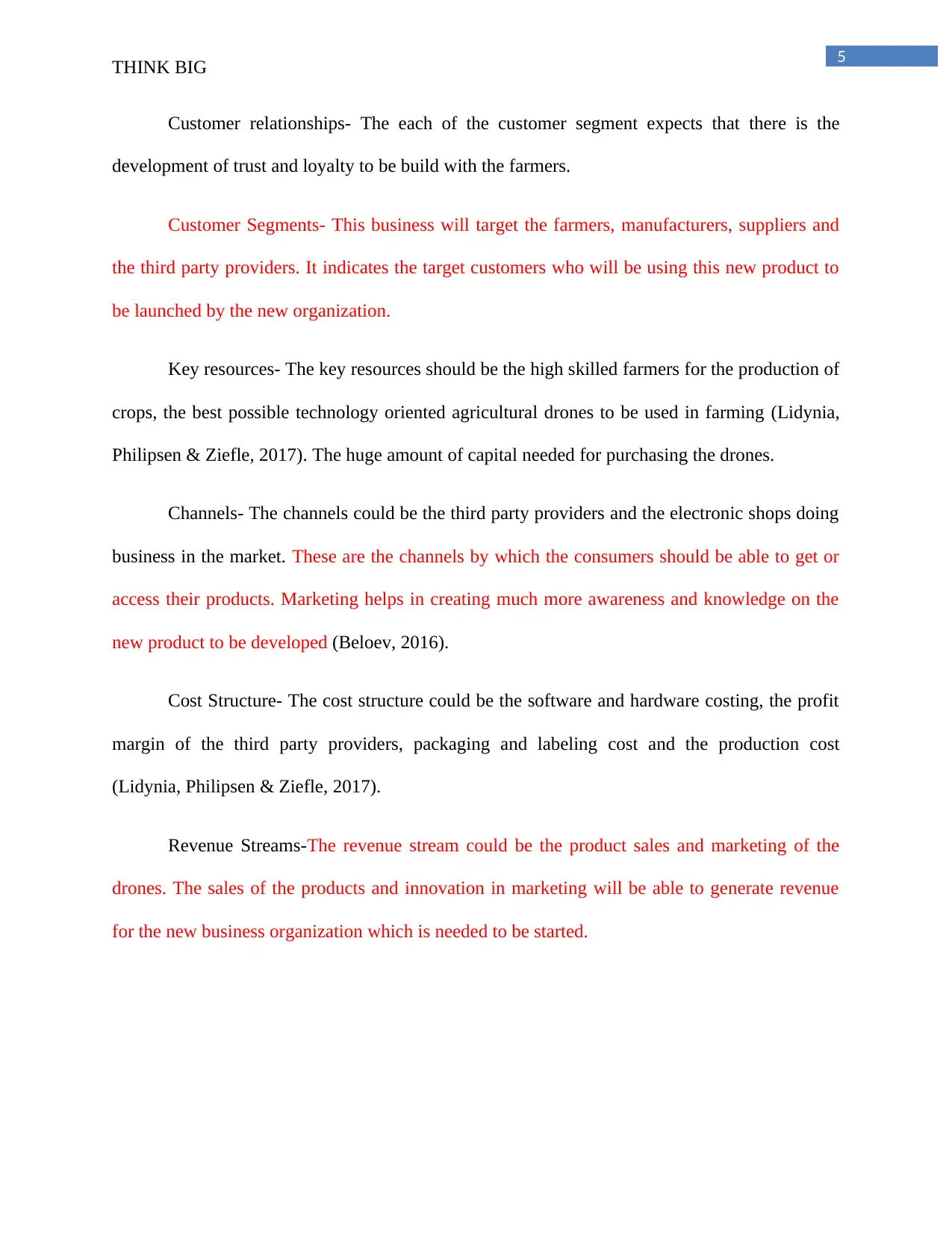
5
THINK BIG
Customer relationships- The each of the customer segment expects that there is the
development of trust and loyalty to be build with the farmers.
Customer Segments- This business will target the farmers, manufacturers, suppliers and
the third party providers. It indicates the target customers who will be using this new product to
be launched by the new organization.
Key resources- The key resources should be the high skilled farmers for the production of
crops, the best possible technology oriented agricultural drones to be used in farming (Lidynia,
Philipsen & Ziefle, 2017). The huge amount of capital needed for purchasing the drones.
Channels- The channels could be the third party providers and the electronic shops doing
business in the market. These are the channels by which the consumers should be able to get or
access their products. Marketing helps in creating much more awareness and knowledge on the
new product to be developed (Beloev, 2016).
Cost Structure- The cost structure could be the software and hardware costing, the profit
margin of the third party providers, packaging and labeling cost and the production cost
(Lidynia, Philipsen & Ziefle, 2017).
Revenue Streams-The revenue stream could be the product sales and marketing of the
drones. The sales of the products and innovation in marketing will be able to generate revenue
for the new business organization which is needed to be started.
THINK BIG
Customer relationships- The each of the customer segment expects that there is the
development of trust and loyalty to be build with the farmers.
Customer Segments- This business will target the farmers, manufacturers, suppliers and
the third party providers. It indicates the target customers who will be using this new product to
be launched by the new organization.
Key resources- The key resources should be the high skilled farmers for the production of
crops, the best possible technology oriented agricultural drones to be used in farming (Lidynia,
Philipsen & Ziefle, 2017). The huge amount of capital needed for purchasing the drones.
Channels- The channels could be the third party providers and the electronic shops doing
business in the market. These are the channels by which the consumers should be able to get or
access their products. Marketing helps in creating much more awareness and knowledge on the
new product to be developed (Beloev, 2016).
Cost Structure- The cost structure could be the software and hardware costing, the profit
margin of the third party providers, packaging and labeling cost and the production cost
(Lidynia, Philipsen & Ziefle, 2017).
Revenue Streams-The revenue stream could be the product sales and marketing of the
drones. The sales of the products and innovation in marketing will be able to generate revenue
for the new business organization which is needed to be started.
⊘ This is a preview!⊘
Do you want full access?
Subscribe today to unlock all pages.

Trusted by 1+ million students worldwide
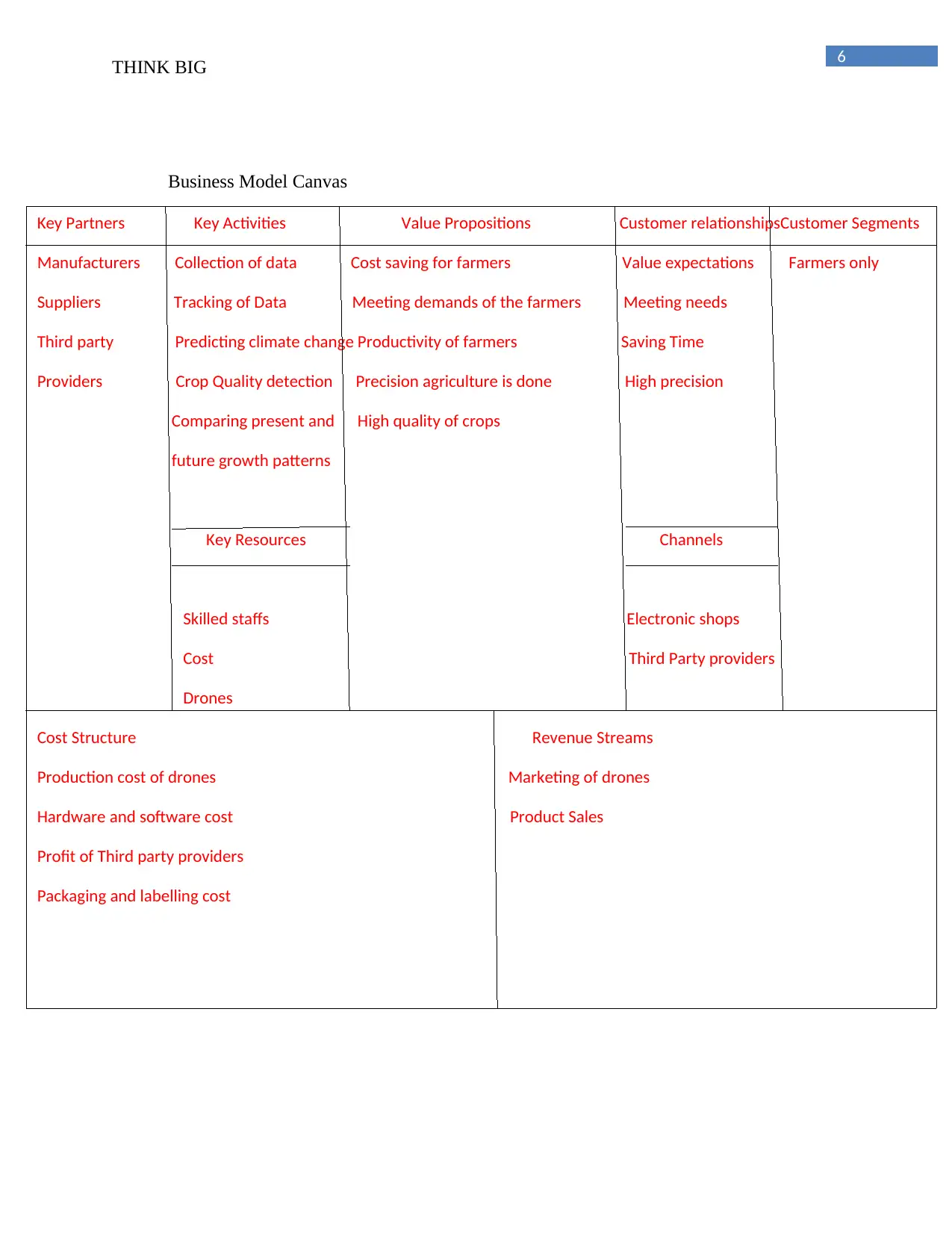
6
THINK BIG
Business Model Canvas
Key Partners Key Activities Value Propositions Customer relationshipsCustomer Segments
Manufacturers Collection of data Cost saving for farmers Value expectations Farmers only
Suppliers Tracking of Data Meeting demands of the farmers Meeting needs
Third party Predicting climate change Productivity of farmers Saving Time
Providers Crop Quality detection Precision agriculture is done High precision
Comparing present and High quality of crops
future growth patterns
Key Resources Channels
Skilled staffs Electronic shops
Cost Third Party providers
Drones
Cost Structure Revenue Streams
Production cost of drones Marketing of drones
Hardware and software cost Product Sales
Profit of Third party providers
Packaging and labelling cost
THINK BIG
Business Model Canvas
Key Partners Key Activities Value Propositions Customer relationshipsCustomer Segments
Manufacturers Collection of data Cost saving for farmers Value expectations Farmers only
Suppliers Tracking of Data Meeting demands of the farmers Meeting needs
Third party Predicting climate change Productivity of farmers Saving Time
Providers Crop Quality detection Precision agriculture is done High precision
Comparing present and High quality of crops
future growth patterns
Key Resources Channels
Skilled staffs Electronic shops
Cost Third Party providers
Drones
Cost Structure Revenue Streams
Production cost of drones Marketing of drones
Hardware and software cost Product Sales
Profit of Third party providers
Packaging and labelling cost
Paraphrase This Document
Need a fresh take? Get an instant paraphrase of this document with our AI Paraphraser
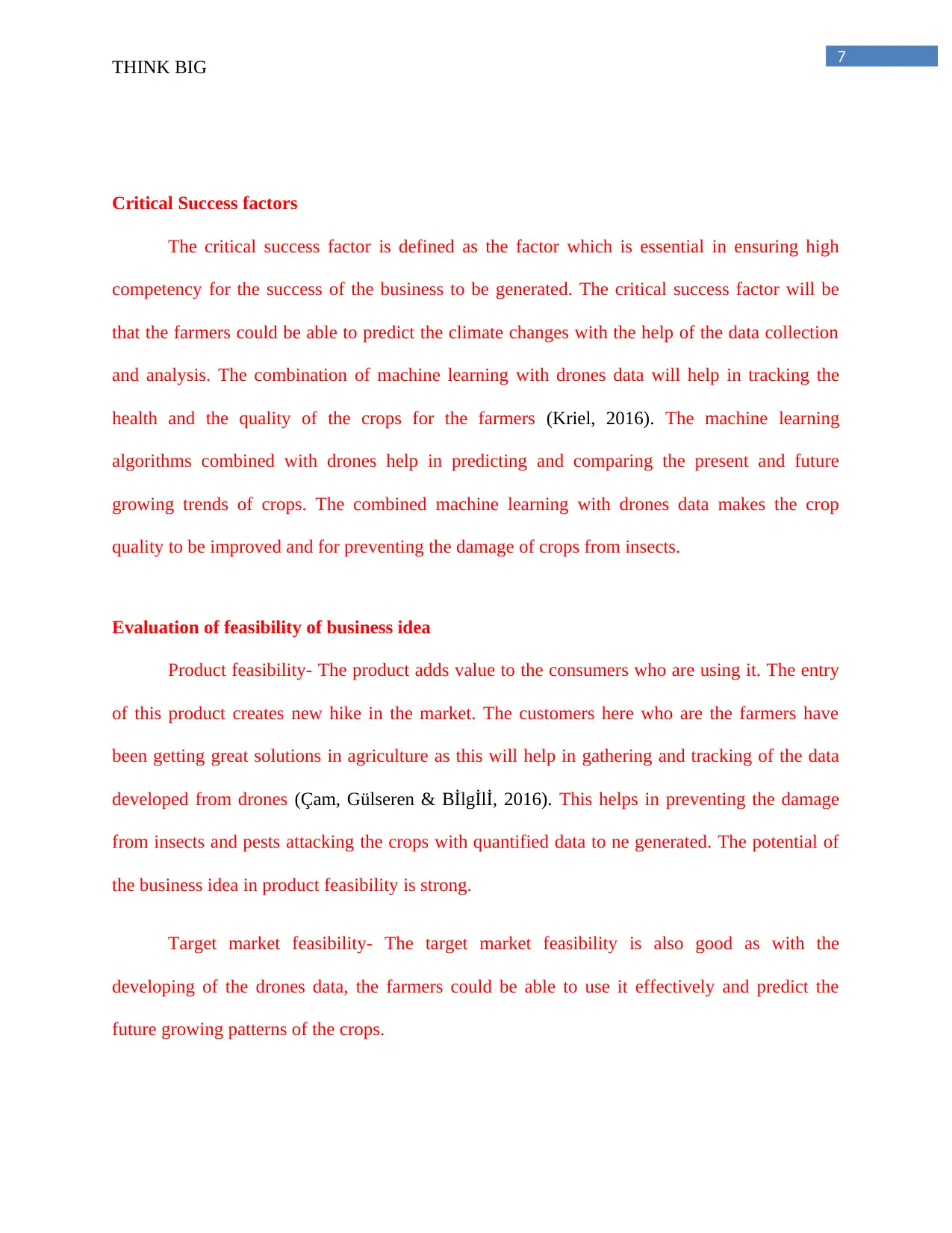
7
THINK BIG
Critical Success factors
The critical success factor is defined as the factor which is essential in ensuring high
competency for the success of the business to be generated. The critical success factor will be
that the farmers could be able to predict the climate changes with the help of the data collection
and analysis. The combination of machine learning with drones data will help in tracking the
health and the quality of the crops for the farmers (Kriel, 2016). The machine learning
algorithms combined with drones help in predicting and comparing the present and future
growing trends of crops. The combined machine learning with drones data makes the crop
quality to be improved and for preventing the damage of crops from insects.
Evaluation of feasibility of business idea
Product feasibility- The product adds value to the consumers who are using it. The entry
of this product creates new hike in the market. The customers here who are the farmers have
been getting great solutions in agriculture as this will help in gathering and tracking of the data
developed from drones (Çam, Gülseren & Bİlgİlİ, 2016). This helps in preventing the damage
from insects and pests attacking the crops with quantified data to ne generated. The potential of
the business idea in product feasibility is strong.
Target market feasibility- The target market feasibility is also good as with the
developing of the drones data, the farmers could be able to use it effectively and predict the
future growing patterns of the crops.
THINK BIG
Critical Success factors
The critical success factor is defined as the factor which is essential in ensuring high
competency for the success of the business to be generated. The critical success factor will be
that the farmers could be able to predict the climate changes with the help of the data collection
and analysis. The combination of machine learning with drones data will help in tracking the
health and the quality of the crops for the farmers (Kriel, 2016). The machine learning
algorithms combined with drones help in predicting and comparing the present and future
growing trends of crops. The combined machine learning with drones data makes the crop
quality to be improved and for preventing the damage of crops from insects.
Evaluation of feasibility of business idea
Product feasibility- The product adds value to the consumers who are using it. The entry
of this product creates new hike in the market. The customers here who are the farmers have
been getting great solutions in agriculture as this will help in gathering and tracking of the data
developed from drones (Çam, Gülseren & Bİlgİlİ, 2016). This helps in preventing the damage
from insects and pests attacking the crops with quantified data to ne generated. The potential of
the business idea in product feasibility is strong.
Target market feasibility- The target market feasibility is also good as with the
developing of the drones data, the farmers could be able to use it effectively and predict the
future growing patterns of the crops.
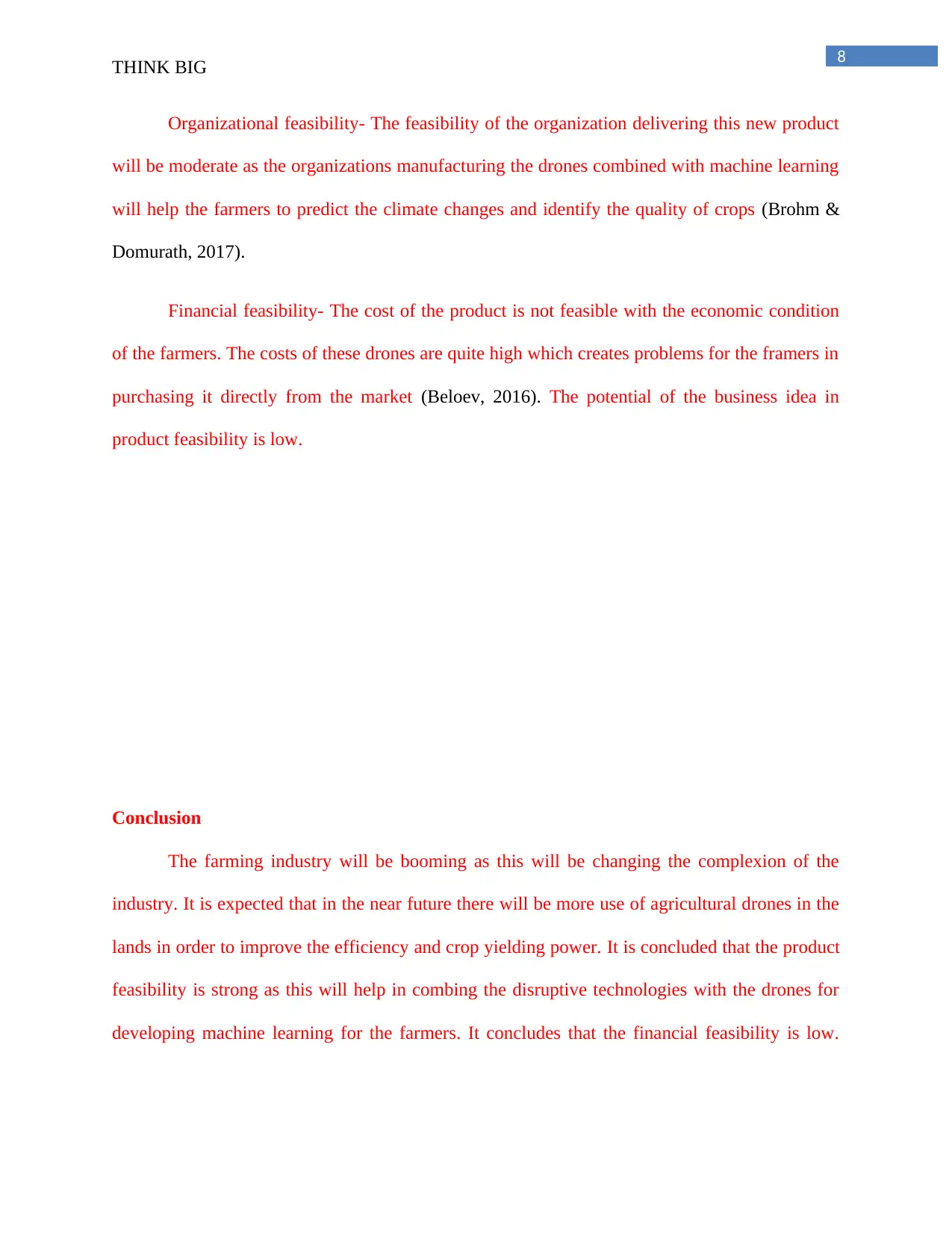
8
THINK BIG
Organizational feasibility- The feasibility of the organization delivering this new product
will be moderate as the organizations manufacturing the drones combined with machine learning
will help the farmers to predict the climate changes and identify the quality of crops (Brohm &
Domurath, 2017).
Financial feasibility- The cost of the product is not feasible with the economic condition
of the farmers. The costs of these drones are quite high which creates problems for the framers in
purchasing it directly from the market (Beloev, 2016). The potential of the business idea in
product feasibility is low.
Conclusion
The farming industry will be booming as this will be changing the complexion of the
industry. It is expected that in the near future there will be more use of agricultural drones in the
lands in order to improve the efficiency and crop yielding power. It is concluded that the product
feasibility is strong as this will help in combing the disruptive technologies with the drones for
developing machine learning for the farmers. It concludes that the financial feasibility is low.
THINK BIG
Organizational feasibility- The feasibility of the organization delivering this new product
will be moderate as the organizations manufacturing the drones combined with machine learning
will help the farmers to predict the climate changes and identify the quality of crops (Brohm &
Domurath, 2017).
Financial feasibility- The cost of the product is not feasible with the economic condition
of the farmers. The costs of these drones are quite high which creates problems for the framers in
purchasing it directly from the market (Beloev, 2016). The potential of the business idea in
product feasibility is low.
Conclusion
The farming industry will be booming as this will be changing the complexion of the
industry. It is expected that in the near future there will be more use of agricultural drones in the
lands in order to improve the efficiency and crop yielding power. It is concluded that the product
feasibility is strong as this will help in combing the disruptive technologies with the drones for
developing machine learning for the farmers. It concludes that the financial feasibility is low.
⊘ This is a preview!⊘
Do you want full access?
Subscribe today to unlock all pages.

Trusted by 1+ million students worldwide

9
THINK BIG
The innovation in the application of drone will help in improving the predictions of growing
patterns and prevent the damage of the crops.
THINK BIG
The innovation in the application of drone will help in improving the predictions of growing
patterns and prevent the damage of the crops.
Paraphrase This Document
Need a fresh take? Get an instant paraphrase of this document with our AI Paraphraser
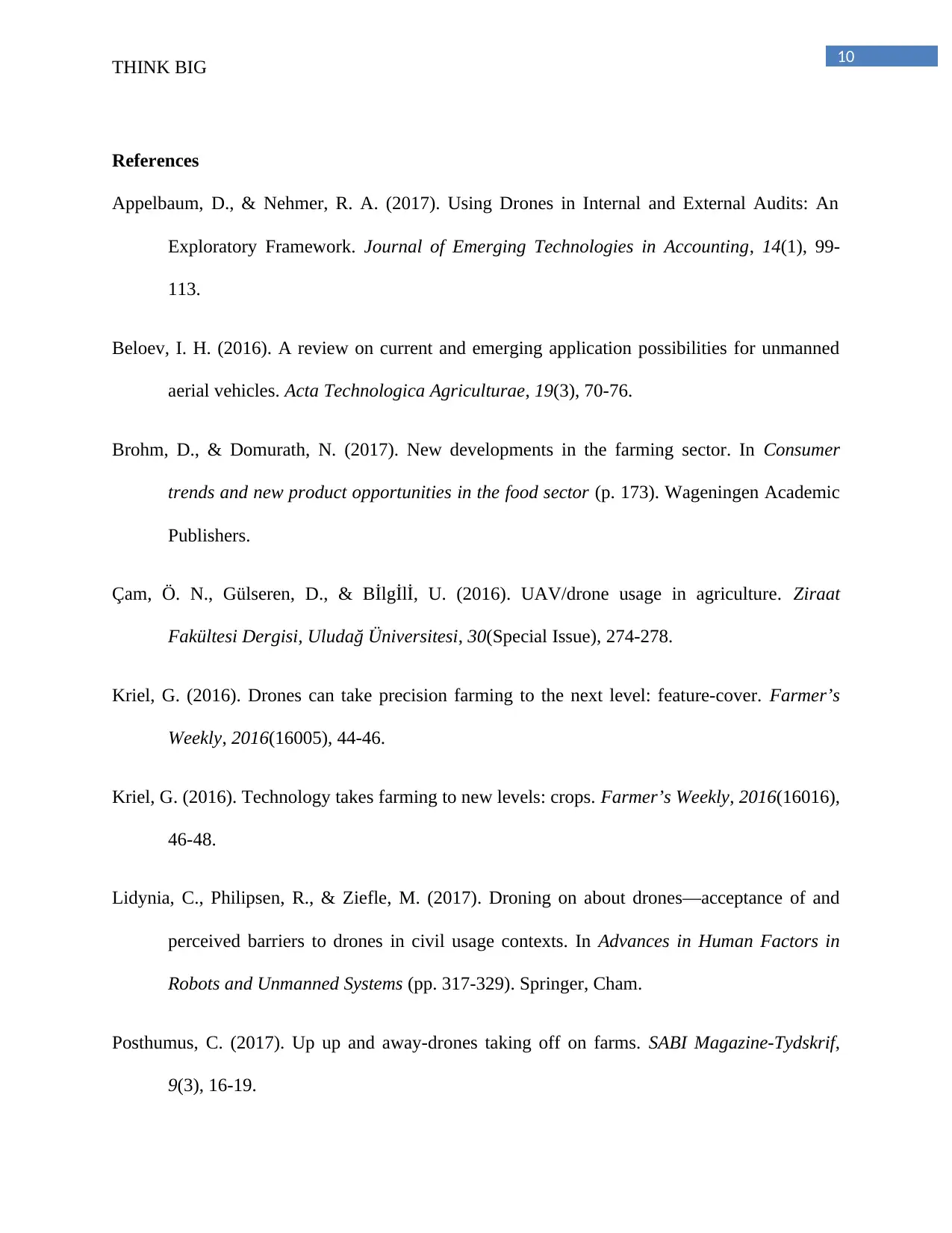
10
THINK BIG
References
Appelbaum, D., & Nehmer, R. A. (2017). Using Drones in Internal and External Audits: An
Exploratory Framework. Journal of Emerging Technologies in Accounting, 14(1), 99-
113.
Beloev, I. H. (2016). A review on current and emerging application possibilities for unmanned
aerial vehicles. Acta Technologica Agriculturae, 19(3), 70-76.
Brohm, D., & Domurath, N. (2017). New developments in the farming sector. In Consumer
trends and new product opportunities in the food sector (p. 173). Wageningen Academic
Publishers.
Çam, Ö. N., Gülseren, D., & Bİlgİlİ, U. (2016). UAV/drone usage in agriculture. Ziraat
Fakültesi Dergisi, Uludağ Üniversitesi, 30(Special Issue), 274-278.
Kriel, G. (2016). Drones can take precision farming to the next level: feature-cover. Farmer’s
Weekly, 2016(16005), 44-46.
Kriel, G. (2016). Technology takes farming to new levels: crops. Farmer’s Weekly, 2016(16016),
46-48.
Lidynia, C., Philipsen, R., & Ziefle, M. (2017). Droning on about drones—acceptance of and
perceived barriers to drones in civil usage contexts. In Advances in Human Factors in
Robots and Unmanned Systems (pp. 317-329). Springer, Cham.
Posthumus, C. (2017). Up up and away-drones taking off on farms. SABI Magazine-Tydskrif,
9(3), 16-19.
THINK BIG
References
Appelbaum, D., & Nehmer, R. A. (2017). Using Drones in Internal and External Audits: An
Exploratory Framework. Journal of Emerging Technologies in Accounting, 14(1), 99-
113.
Beloev, I. H. (2016). A review on current and emerging application possibilities for unmanned
aerial vehicles. Acta Technologica Agriculturae, 19(3), 70-76.
Brohm, D., & Domurath, N. (2017). New developments in the farming sector. In Consumer
trends and new product opportunities in the food sector (p. 173). Wageningen Academic
Publishers.
Çam, Ö. N., Gülseren, D., & Bİlgİlİ, U. (2016). UAV/drone usage in agriculture. Ziraat
Fakültesi Dergisi, Uludağ Üniversitesi, 30(Special Issue), 274-278.
Kriel, G. (2016). Drones can take precision farming to the next level: feature-cover. Farmer’s
Weekly, 2016(16005), 44-46.
Kriel, G. (2016). Technology takes farming to new levels: crops. Farmer’s Weekly, 2016(16016),
46-48.
Lidynia, C., Philipsen, R., & Ziefle, M. (2017). Droning on about drones—acceptance of and
perceived barriers to drones in civil usage contexts. In Advances in Human Factors in
Robots and Unmanned Systems (pp. 317-329). Springer, Cham.
Posthumus, C. (2017). Up up and away-drones taking off on farms. SABI Magazine-Tydskrif,
9(3), 16-19.
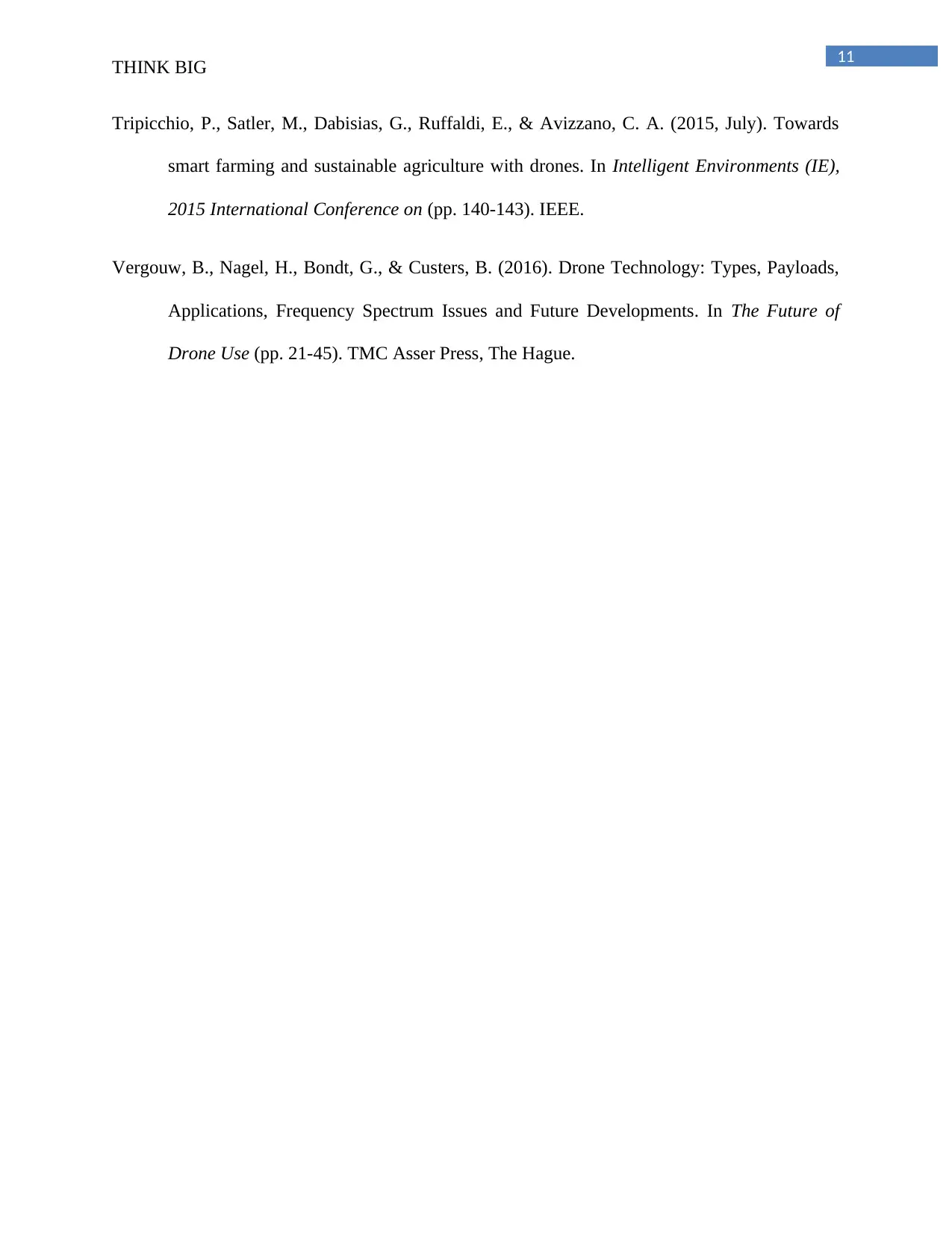
11
THINK BIG
Tripicchio, P., Satler, M., Dabisias, G., Ruffaldi, E., & Avizzano, C. A. (2015, July). Towards
smart farming and sustainable agriculture with drones. In Intelligent Environments (IE),
2015 International Conference on (pp. 140-143). IEEE.
Vergouw, B., Nagel, H., Bondt, G., & Custers, B. (2016). Drone Technology: Types, Payloads,
Applications, Frequency Spectrum Issues and Future Developments. In The Future of
Drone Use (pp. 21-45). TMC Asser Press, The Hague.
THINK BIG
Tripicchio, P., Satler, M., Dabisias, G., Ruffaldi, E., & Avizzano, C. A. (2015, July). Towards
smart farming and sustainable agriculture with drones. In Intelligent Environments (IE),
2015 International Conference on (pp. 140-143). IEEE.
Vergouw, B., Nagel, H., Bondt, G., & Custers, B. (2016). Drone Technology: Types, Payloads,
Applications, Frequency Spectrum Issues and Future Developments. In The Future of
Drone Use (pp. 21-45). TMC Asser Press, The Hague.
⊘ This is a preview!⊘
Do you want full access?
Subscribe today to unlock all pages.

Trusted by 1+ million students worldwide
1 out of 19
Related Documents
Your All-in-One AI-Powered Toolkit for Academic Success.
+13062052269
info@desklib.com
Available 24*7 on WhatsApp / Email
![[object Object]](/_next/static/media/star-bottom.7253800d.svg)
Unlock your academic potential
Copyright © 2020–2025 A2Z Services. All Rights Reserved. Developed and managed by ZUCOL.




